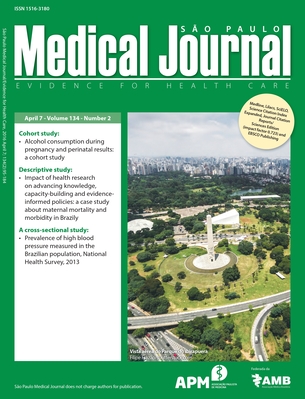Determination of a cutoff value for pelvic floor distensibility using the Epi-no balloon to predict perineal integrity in vaginal delivery
ROC curve analysis. Prospective observational single cohort study
Keywords:
Physical therapy modalities, Pelvic floor, Perineum, Labor stage, first, ParturitionAbstract
CONTEXT AND OBJECTIVE: Several risk factors are involved in perineal lacerations during vaginal delivery. However, little is known about the influence of perineal distensibility as a protective factor. The aim here was to determine a cutoff value for pelvic floor distensibility measured using the Epi-no balloon, which could be used as a predictive factor for perineal integrity in vaginal delivery. DESIGN AND SETTING: Prospective observational single cohort study conducted in a maternity hospital. METHODS: A convenience sample of 227 consecutive at-term parturients was used. All women had a single fetus in the vertex presentation, with up to 9.0 cm of dilation. The maximum dilation of the Epi-no balloon was measured using a tape measure after it had been inflated inside the vagina up to the parturients’ maximum tolerance. The receiver operating characteristic (ROC) curve was used to obtain the Epi-no circumference measurement with best sensitivity and specificity. RESULTS: Among the 161 patients who were included in the study, 50.9% underwent episiotomy, 21.8% presented lacerations and 27.3% retained an intact perineum. Age > 25.9 years; number of pregnancies > 3.4; number of deliveries > 2.2 and circumference measured by Epi-no > 21.4 cm were all directly correlated with an intact perineum. Circumference measurements using the Epi-no balloon that were greater than 20.8 cm showed sensitivity and specificity of 70.5% and 66.7% (area under curve = 0.713), respectively, as a predictive factor for an intact perineum in vaginal delivery. CONCLUSION: Circumferences greater than 20.8 cm achieved using the Epi-no balloon are a predictive factor for perineal integrity in parturients.
Downloads
References
Yiou R, Costa P, Haab F, Delmas V. Anatomie fonctionnelle du plancher pelvien [Functional anatomy of the pelvic floor]. Prog Urol. 2009;19(13):916-25.
Shek KL, Dietz HP. Intrapartum risk factors for levator trauma. BJOG. 2010;117(12):1485-92.
World Health Organization. Classification of practices in normal birth. Geneva: In: World Health Organization: Care in normal birth: a practical guide. Report a technical working group. Report No.: WHO Technical Report Series FRH/MSM/96.24; 1996. p. 34-7. Available from: http://whqlibdoc.who.int/hq/1996/WHO_FRH_MSM_96.24.pdf?ua=1. Accessed in 2014 (Aug 15).
Shek KL, Dietz HP. The effect of childbirth on hiatal dimensions. Obstet Gynecol. 2009;113(6):1272-8.
Dietz HP, Lanzarone V. Levator trauma after vaginal delivery. Obstet Gynecol. 2005;106(4):707-12.
Dietz HP, Shek C, De Leon J, Steensma AB. Ballooning of the levator hiatus. Ultrasound Obstet Gynecol. 2008;31(6):676-80.
Labrecque M, Eason E, Marcoux S. Women’s views on the practice of prenatal perineal massage. BJOG. 2001;108(5):499-504.
Howard D, Davies PS, DeLancey JO, Small Y. Differences in perineal lacerations in black and white primiparas. Obstet Gynecol. 2000;96(4):622-4.
Goldberg RP, Kwon C, Gandhi S, et al. Urinary incontinence among mothers of multiples: the protective effect of cesarean delivery. Am J Obstet Gynecol. 2003;188(6):1447-50; discussion 1450-3.
Burgio KL, Borello-France D, Richter HE, et al. Risk factors for fecal and urinary incontinence after childbirth: the childbirth and pelvic symptoms study. Am J Gastroenterol. 2007;102(9):1998-2004.
Ashton-Miller JA, Delancey JO. On the biomechanics of vaginal birth and common sequelae. Annu Rev Biomed Eng. 2009;13:163-76.
Kovacs GT, Heath P, Heather C. First Australian trial of the birth- training device Epi-No: a highly significantly increased chance of an intact perineum. Aust N Z J Obstet Gynaecol. 2004;44(4):347-8.
Kubotani JS, Moron AF, Araujo Júnior E, et al. Perineal Distensibility Using Epi-no in Twin Pregnancies: Comparative Study with Singleton Pregnancies. ISRN Obstet Gynecol. 2014;2014:124206.
Dupuis O, Silveira R, Zentner A, et al. Birth simulator: reliability of transvaginal assessment of fetal head station as defined by the American College of Obstetricians and Gynecologists classification. Am J Obstet Gynecol. 2005;192(3):868-74.
Ruckhäberle E, Jundt K, Bäuerle M, et al. Prospective randomized multicentre trial with the birth trainer EPI-NO for the prevention of perineal trauma. Aust N Z J Obstet Gynaecol. 2009;49(5):478-83.
Martins WP, Lima JC, Welsh AW, et al. Three-dimensional Doppler evaluation of single spherical samples from the placenta: intra- and interobserver reliability. Ultrasound Obstet Gynecol. 2012;40(2):200-6.
Rodriguez A, Arenas EA, Osorio AL, Mendez O, Zuleta JJ. Selective vs routine midline episiotomy for the prevention of third- or fourth- degree lacerations in nulliparous women. Am J Obstet Gynecol. 2008;198(3):285.e1-4.
Astrand PO, Rodahl K. Textbook of work physiology: physiological bases of exercise. New York: McGraw-Hill; 1977.
Shek KL, Dietz HP. Can levator avulsion be predicted antenatally? Am J Obstet Gynecol. 2010;202(6):586.e1-6.
Vershinin AE, Nazarenko GF. Uglomer dlia opredeleniia amplitudy dvizhenii v sheinom otdele pozvonochnika [Goniometer for determining the amplitude of motion in the cervical spine]. Ortop Travmatol Protez. 1986;(9):49-50.
Bracken JN, Dryfhout VL, Goldenhar LM, Pauls RN. Preferences and concerns for delivery: an antepartum survey. Int Urogynecol J Pelvic Floor Dysfunct. 2008;19(11):1527-31.
Agência Nacional de Saúde Suplementar (Brasil). O modelo de atenção obstétrica no setor de Saúde Suplementar no Brasil: cenários e perspectivas/Agência Nacional de Saúde Suplementar. Rio de Janeiro: ANS; 2008. Available from: www.ans.gov.br/portal/upload/biblioteca/livro_parto_web.pdf. Accessed in 2014 (Aug 15).
Shek KL, Chantarasorn V, Langer S, Phipps H, Dietz HP. Does the Epi- No Birth Trainer reduce levator trauma? A randomised controlled trial. Int Urogynecol J. 2011;22(12):1521-8.
Dietz HP, Shek C. Levator avulsion and grading of pelvic floor muscle strength. Int Urogynecol J Pelvic Floor Dysfunct. 2008;19(5):633-6.
Nicoll LM, Skupski DW. Venous air embolism after using a birth- training device. Obstet Gynecol. 2008;111(2 Pt 2):489-91.
Lien KC, Mooney B, DeLancey JO, Ashton-Miller JA. Levator ani muscle stretch induced by simulated vaginal birth. Obstet Gynecol. 2004;103(1):31-40.
Hoyte L, Damaser MS, Warfield SK, et al. Quantity and distribution of levator ani stretch during simulated vaginal childbirth. Am J Obstet Gynecol. 2008;199(2):198.e1-5.






